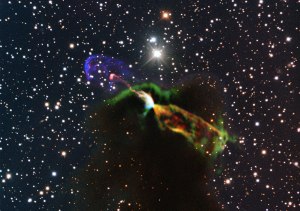Bok globules are small interstellar clouds of very cold gas and dust that are nearly totally opaque to visible light as we’ve already seen in a previous post. Although they can be studied with infrared and radio techniques. They were originally discovered as black splotches in front of dense fields of stars, and were even dubbed “holes in the heaven” because they appeared like holes in the stellar background. Bok globules are typically less than 100 solar-masses in size.
A telescope in Chile, has captured in 2013 images of a Bok globule with what astronomers presume is a baby star lighting up an interstellar cloud with jets of gas streaking through deep space at very high speeds, the jet is on the top left corner the Bok globule is the black cloud in the center of the image taken in visible light:

This image from ESO’s New Technology Telescope at the La Silla Observatory in Chile shows the Herbig-Haro object HH 46/47 as jets emerging from a star-forming dark cloud.

This Hubble telescope view of the same region as above but with more details, show a three trillion mile-long jet called HH-47 reveals a very complicated jet pattern that indicates the star (hidden inside a dust cloud near the right bottom edge of the image).
Now, what the astronomers have discovered in 2013, using a radio telescope in Chile this time was quite astonishing. They show the nascent star about 1,400 light-years from Earth, inside our Milky Way, unleashing material at nearly 84,477 mph (144,000 km/h), which then crashes into surrounding gas, causing it to glow.
The glowing object spawned by the newborn star is what scientists call a Herbig-Haro object (That’s why it is also called HH46/47). These new, detailed images showed that the material is streaking out of the star at about 40 kilometers per second (nearly 25 miles per second), One jet appears on the left side of the photo in pink and purple/blue streaming partially toward Earth (this correspond to what we can see in the visible spectrum in the images above), while the orange and green jet on the right-hand-side show a jet pointed away from Earth (this is actually inside the Bok globule and could not be seen i the Hubble picture in the visible spectrum above). The picture is also unusual because the outflow impacts the cloud directly on one side of the young star and escapes out of the cloud on the other:

Astronomers using the Atacama Large Millimeter/sub millimeter Array (ALMA) have obtained a vivid close-up view of material streaming away from a newborn star. By looking at the glow coming from carbon monoxide molecules in an object called Herbig-Haro 46/47 they have discovered that its jets are even more energetic than previously thought. In these observations from ALMA the colors shown represent the motions of the material: the blue parts at the left are a jet approaching the Earth (blue shifted) and the larger jet on the right is receding (red shifted).

Combination of the image above at the beginning of this post in the visible spectrum and the previous infrared and radio spectrum images
Most stars produce powerful outflow jets of matter while they are forming, in a process that is not yet completely understood. It is thought that the jets may help slow the young star’s spin, in the same process that causes a spinning skater to slow down when extending arms outwards. By preventing the star from spinning too fast, the jets may help the star continue its growth by allowing it to continue gathering infalling material. The jets are associated with the presence of an accretion disk that surrounds the young star. Such disks contain the material from which planets and moons could eventually form. Our Sun probably underwent a similar process some 4.5 billion years ago.

Herbig–Haro (HH) objects are small patches of nebulosity associated with newly born stars, and are formed when narrow jets of gas ejected by young stars collide with clouds of gas and dust nearby at speeds of several hundred kilometres per second. Herbig–Haro objects are ubiquitous in star-forming regions, and several are often seen around a single star, aligned with its rotational axis.
These pictures are really breath taking once one understands what nature is doing. I have spent some time trying to put pieces of the puzzle together, but not one single article on this topic has given me enough understanding. I hope that this article will help you grasp the beauty of this phenomenon and make you want to search for more information on for example, star’s accretion disk and outflow jets.
UPDATE 2016-04-17:
In December 2015, the following Hubble image about the topic of this post has been released to the public:
Herbig-Haro Jet HH 24
This link is the APOD comments on this fantastic picture:
APOD on HH-24
References:
Pankaj Jain (2015). An Introduction to ASTRONOMY AND ASTROPHYSICS.
